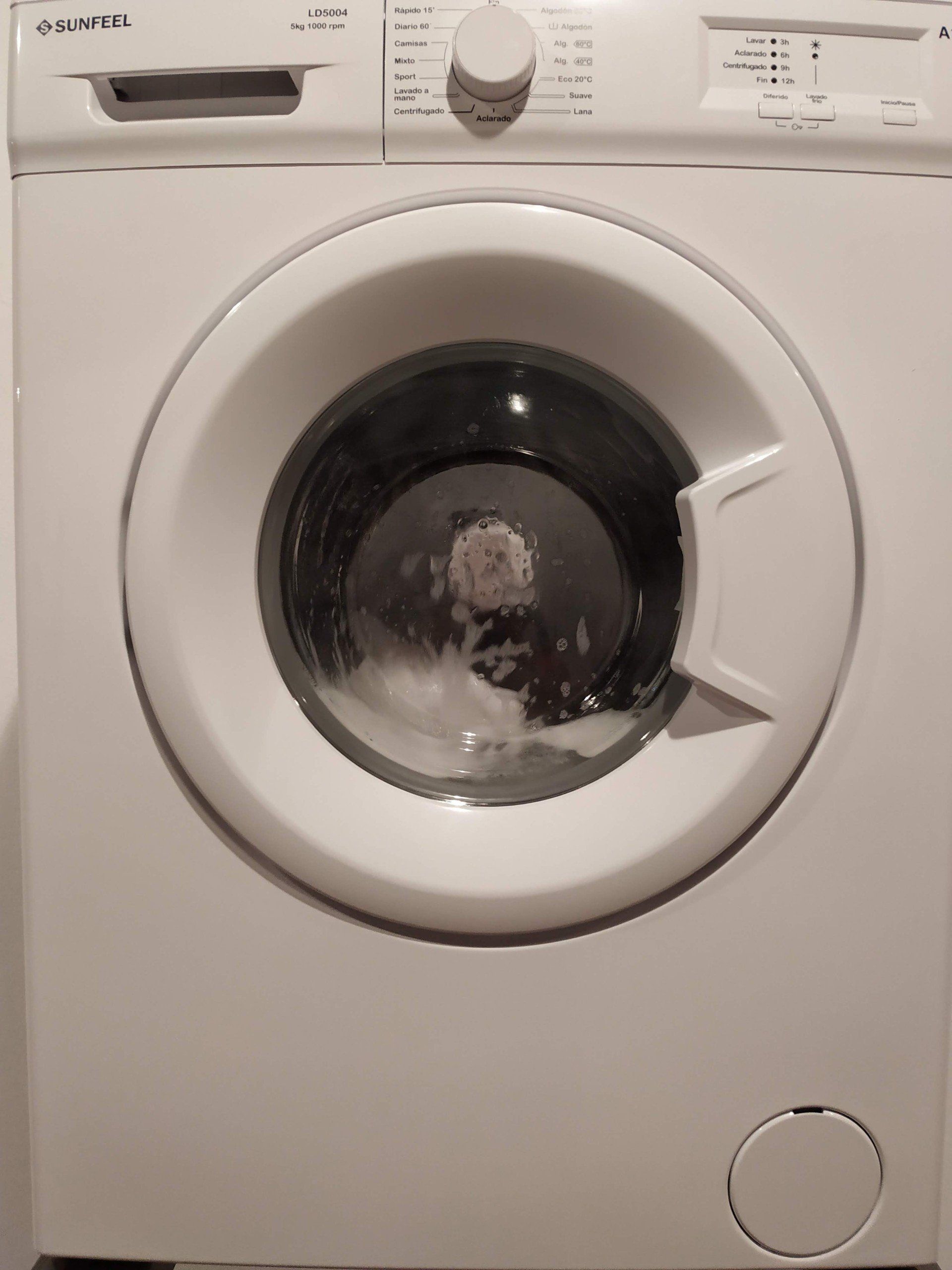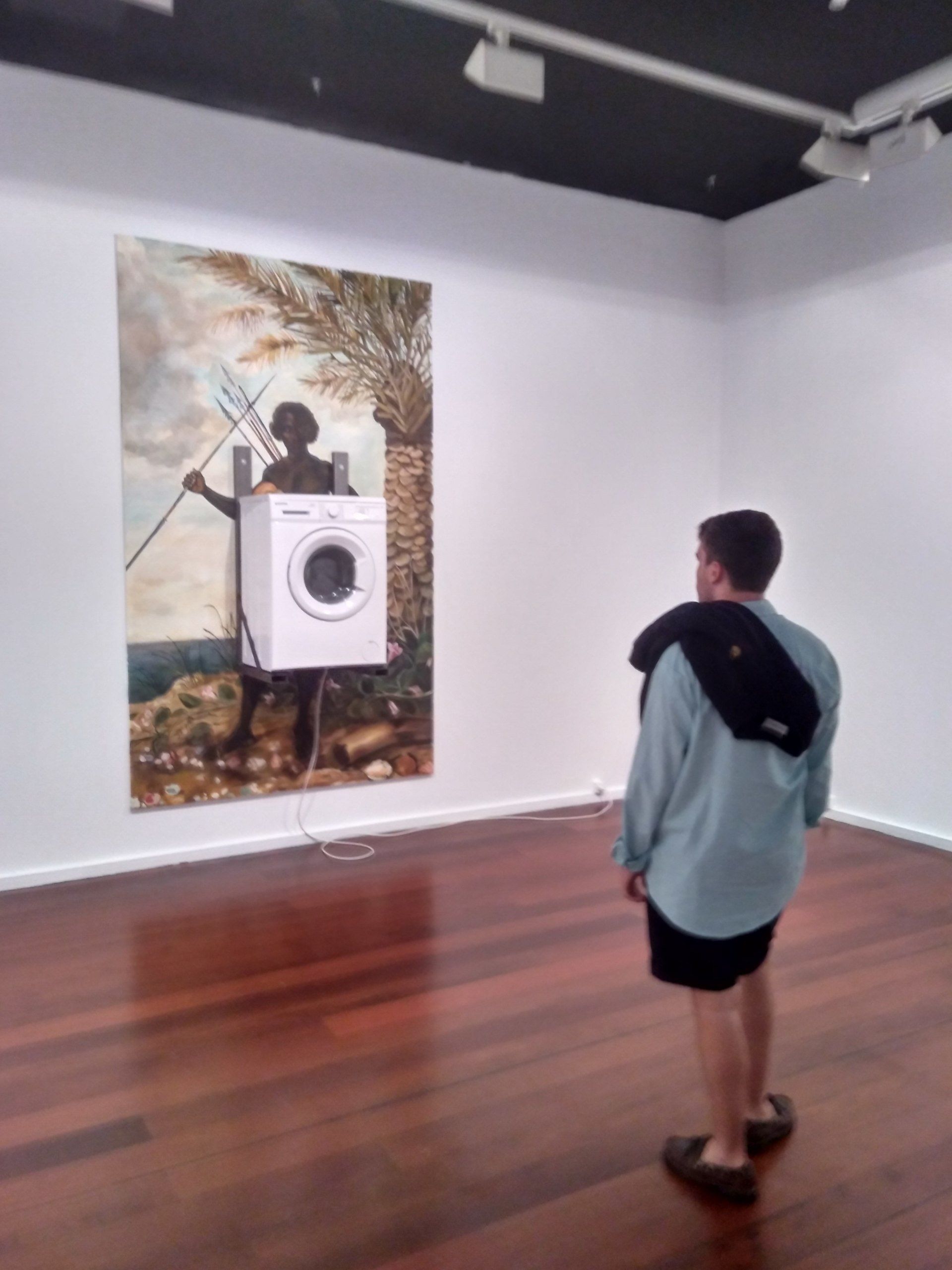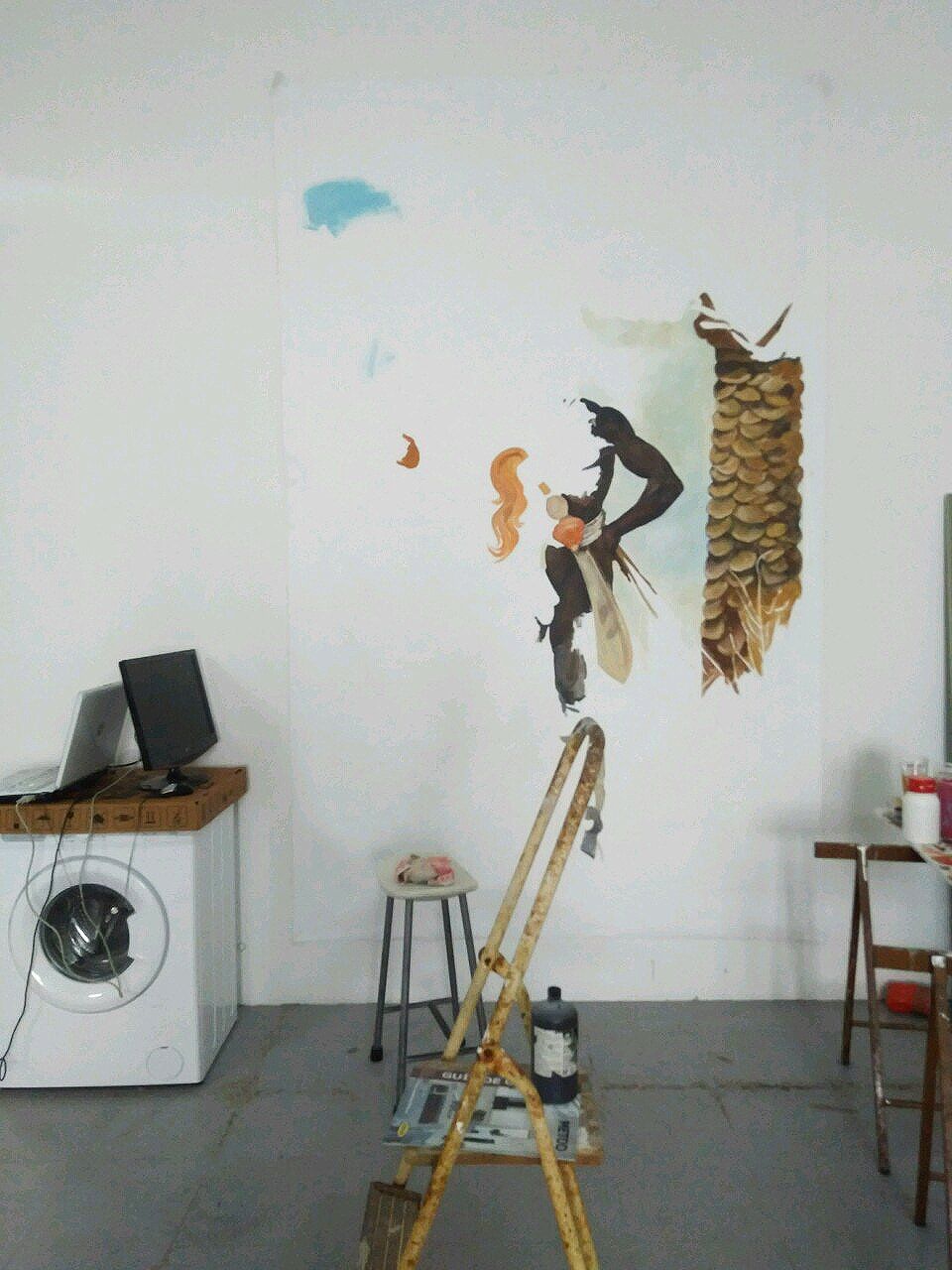Segundo Origen #2
Pintura, lavadoras, agua y hierro.
Instalación. Instituto Cabrera Pinto. Tenerife. 2019
Texto de sala:
La pieza Segundo Origen #2 pretende seguir el rastro que deja tras de sí la imagen de un cuadro que conecta dos puntos del Atlántico negro, como son Canarias y Brasil.
Hemos copiado la pintura Guerreiro negro u Homem negro
del holandés Albert Eckhout en un ejercicio de asimilación y comprensión a través del hecho de copiar una pintura.
El nacimiento de esta imagen parte de un viaje a Brasil organizado por el conde holandés Joao Nassau en representación de los intereses de la Compañía de las Indias Occidentales.
Nassau congregó a un grupo de expedicionarios entre los que se encontraban artistas y científicos cuya misión sería documentar la conquista exitosa de la campaña holandesa en Brasil.
En 1636 la expedición sale de Holanda rumbo al litoral nordeste brasilero y el 23 de diciembre de ese mismo año, otra imagen coloca la flota comandada por Nassau en la Bahía de Garachico, dejando como único rastro una serie de dibujos de Tenerife hechos desde el barco, siendo estos simples esbozos una de las primeras representaciones de las Islas Canarias hechas desde el mar.
Será precisamente el autor de estos dibujos, el holandés Frans Post (considerado históricamente el padre del paisajismo americano) junto a Albert Eckhout, quienes representen en sus pinturas el Brasil desconocido para Europa.
La misión de estos dos artistas era la de construir un diccionario visual del nuevo mundo con la finalidad de que Europa asimilara visualmente América.
Parecía que esas pinturas, en tanto que reflejaban una observación detallada, minuciosa y exhaustiva de lo desconocido, tenían estatus de documento veraz.
Albert Eckhout pasó a la historia como el primer etnógrafo, tratándose su obra casi como etno-pintura. Son bastantes las historiadoras e historiadores que han teorizado sobre las intenciones subyacentes a la serie de 8 retratos étnicos que realizó Eckhout durante su estancia en Brasil, entre los que se encuentra Homem negro o Guerreiro negro. Cuando se observan en conjunto, se ve claramente cómo los retratados con rasgos más indígenas o de piel más negra, están asociados a una simbología salvaje, sexual y caníbal, mientras que el retrato de una mujer mestiza está enmarcado en una hacienda azucarera (la salvaje, ahora, servil y domesticada)
El cuadro de Homem negro, fue supuestamente hecho en Brasil, pero no hay certeza de ello, ya que el cuadro contiene referencias cruzadas que posiblemente el artista recopilase a largo de su viaje. Es probable que realmente el cuadro fuese pintado en Holanda en 1641, edulcorándolo para adaptarlo a los gustos europeos del momento.
En la pintura, en el centro, el retratado lleva un machete con una concha. Esta concha, fue catalogada en una exposición en Sao Paulo en 2018, en la que se colgó el cuadro original, como Concha das Ilhas Canarias.
Este tipo de conchas, llamadas zimbos o caurís, fueron usadas en Canarias y África como moneda de cambio. Después del abandono de esta moneda-concha, se pasó a usar la moneda viva de los cuerpos africanos.
Las expediciones científicas, como las narradas por Albert Eckhout y Frans Post en sus pinturas, construyeron para la mirada etnocéntrica europea un imaginario de la América tropical que había que conquistar y someter.
Es por tanto el rastro de este viaje, el que nos devuelve la mirada interpeladora del Homem negro
sobre nosotr@s, para corroborar que nos urge comprender cómo nuestro imaginario se forjó al servicio del poder colonial y que lo que llamamos descubrimiento no fue otra cosa que sometimiento y barbarie.
Lecuona y Hernández
Garachico, julio de 2019
Gallery text:
The art installation Second Origin #2 aims to follow the trail that the image of a painting that connects two points of the Black Atlantic, such as the Canary Islands and Brazil, leaves behind. We have copied African warrior (Guerreiro negro/Homem negro) painting by the Dutchman Albert Eckhout in an assimilation and understanding exercise by copying a painting. The origin of this image is based on a trip to Brazil organized by the Dutch count Joao Nassau representing the interests of the West Indies Company. Nassau brought together a group of expeditionaries among which were artists and scientists whose mission would be to document the successful conquest of the Dutch campaign in Brazil.
In 1636 the expedition leaves Holland towards the northeast coast of Brazil and on 23rd December of that same year, another image places the fleet commanded by Nassau in the Bay of Garachico, leaving behind a series of drawings of Tenerife made from the ship, being these simple sketches, one of the first representations of the Canary Islands made from the sea.
It will be precisely the author of these drawings, the Dutch Frans Post (historically considered the father of American landscaping) along with Albert Eckhout, who represent in their paintings the unknown Brazil to Europe.
The mission of these two artists was to create a visual dictionary of the new world so Europe would visually assimilate America.
It seemed that these paintings, while reflecting a detailed, thorough and exhaustive observation of the unknown, embodied a truthful document status.
Albert Eckhout went down in history as the first ethnographer, treating his work almost as ethno-painting. A number of historians have theorized about the underlying intentions of the series of 8 ethnical portraits that Eckhout made during his stay in Brazil, among which is African warrior (Guerreiro negro/Homem negro). When viewed together, one can clearly see how those portrayed with more indigenous or black skin features are associated with a wild, sexual and cannibal symbology, while the portrait of a mixed race woman is framed in a sugar farm (the wild, now, servile and domesticated).
The painting African warrior was supposedly made in Brazil, but there is no certainty about this, since the painting contains cross references that the artist could have collected throughout his trip. It is likely that the painting was actually painted in Holland in 1641, in a watered-down version to adapt it to the European tastes of the moment.
In the painting, in the centre, the portrayed carries a machete with a shell. This shell was catalogued in an exhibition in Sao Paulo in 2018, in which the original painting was hung as Concha das Ilhas Canarias.
These types of shells, called zimbos or caurís, were used in the Canary Islands and Africa as currency. After the abandonment of this coin-shell, the African bodies were used as currency.
Scientific expeditions, such as those narrated by Albert Eckhout and Frans Post in their paintings, constituted an imaginary of the tropical America for the ethnocentric European eye that had to be conquered and subdued.
The trail of this trip, therefore, gives us the questioning look of the African Warrior back on us, to confirm that we need to understand how our imaginary was forged in the service of colonial power and what we call discovery was nothing else than submission and barbarism.
Lecuona and Hernández
Garachico, July 2019









